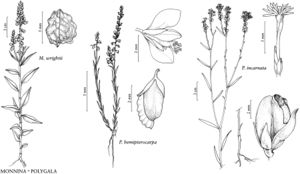Polygala hemipterocarpa
Smithsonian Contr. Knowl. 5(6): 31. 1853.
Herbs perennial, single- or multi-stemmed, 1.2–4(–5.6)[–7.5] dm, unbranched or branched distally; from thickened caudex. Stems erect, sometimes slightly glaucous, usually glabrous, rarely with few scattered, minute hairs, those appressed to incurved. Leaves alternate; sessile or subsessile; blade linear to linear-lanceolate, (3–)6–25 × 0.6–1 mm, base obtuse, apex acute to subacuminate, surfaces glabrous. Racemes loosely cylindric, 3–15(–21) × 0.4–0.8 cm; peduncle 0.5–2.5 cm; bracts deciduous, ovate to lanceolate-ovate. Pedicels 0.5–1 mm, usually glabrous, rarely puberulent. Flowers white, greenish veined, 3–4.5 mm; sepals ovate, 1.6–2.3 mm; wings obovate or elliptic-ovate, 3–4.3 × 1.6–1.8 mm, apex obtuse (rarely to bluntly rounded); keel 3.4 mm, crest 2-parted, with 3 lobes on each side, each 2–4-lobed. Capsules oblong, 4–6.3 × 2.3 mm, abaxial locule not winged, adaxial locule longer, winged, wing broadly scarious, erose-crenulate. Seeds 2.7 mm, pubescent, coat with rows of pits 0.05 mm wide; arils 2 mm, lobes 1/3–2/3 length of seed, vestigial, or to 1/3 length of seed in wingless abaxial locule.
Phenology: Flowering spring–fall.
Habitat: Rocky slopes in grasslands, open woodlands.
Elevation: 1400–2600 m.
Distribution
Ariz., N.Mex., Tex., Mexico (Chihuahua, Durango, eastern Sonora, Tamaulipas).
Discussion
Polygala hemipterocarpa is known only from the Chihuahuan and eastern Sonoran deserts.
Selected References
None.
